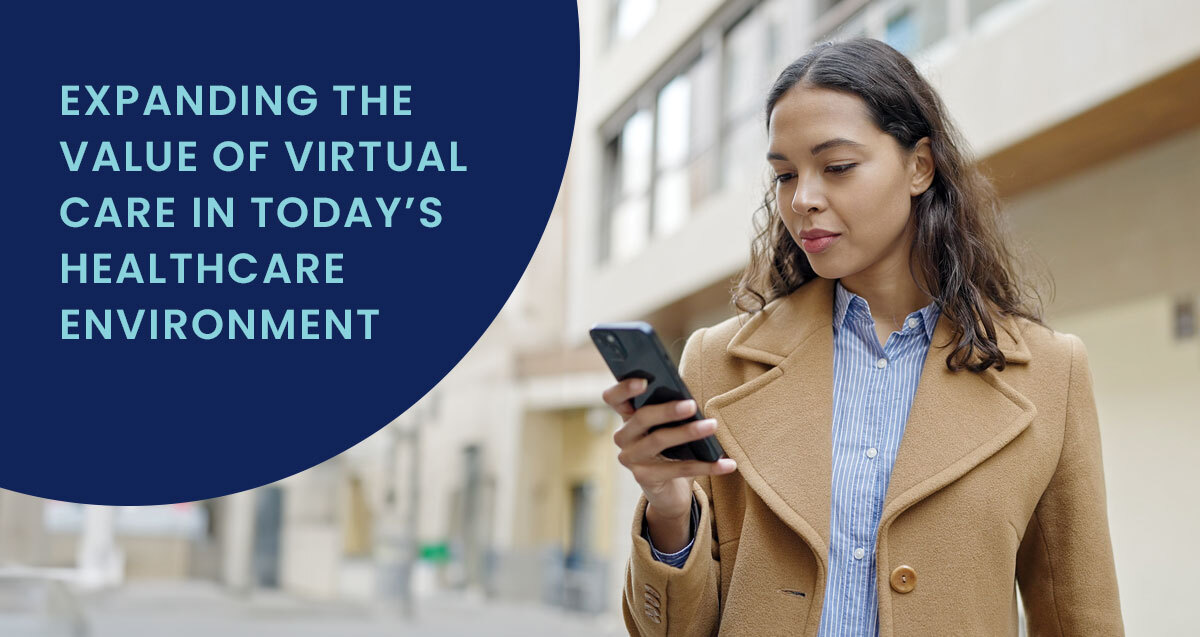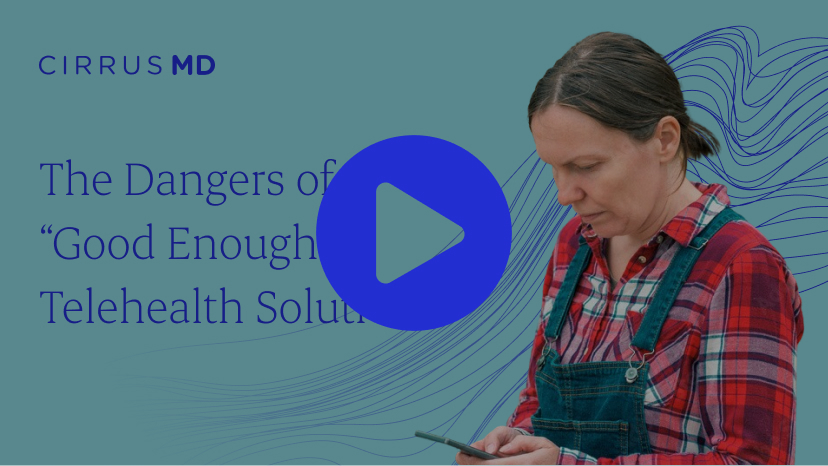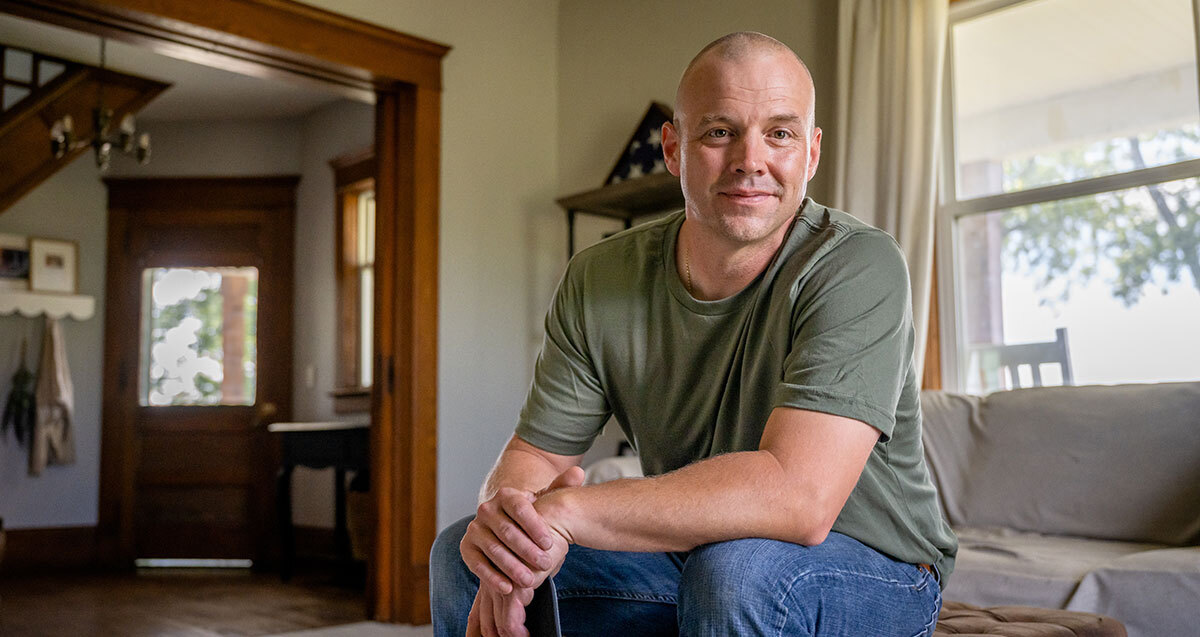
Webinar Summary
COVID-19 has been a trial by fire for self-insured employers and health plans. Whether you already had a legacy telehealth offering or scrambled to put one in place.
As the pandemic slowly abates, however, now may be the ideal time to gauge how your telehealth solution has performed.
- Has it met the challenge or just been mediocre?
- Have your employees embraced it or largely ignored it?
- Has it reduced costs and unnecessary trips to the ER?
Webinar Transcript
Cheryl Flury: Welcome everyone to today's webinar. Thank you so much for taking time from your schedule to join us. I know it's a very busy time and there's so many virtual events to choose from that we really appreciate you taking time from your day to dial into today's webinar, which is the "Dangers of a 'Good Enough' Telehealth Solution.
I'm Cheryl Flurry with CirrusMD, and I'm really pleased to be joined by two of my coworkers, Jeff Voss and Dr. Donna Baldwin. Jeff is the person who heads up sales for our employer of focused outreach. And Donna is one of our physicians on the CirrusMD network, as well as being our chief quality officer and heads up our medical specialty programs. We'll do a little bit more of an introduction to each of them in just a moment.
So, thanks again for taking time to join today's webinar. It's pretty easy to see how this topic came up after this past year and everything that's changed in the way people are seeking and identifying sources for healthcare and also for behavioral health care during the pandemic in the United States and at CirrusMD specifically, we saw huge upticks in people using virtual care services. In fact, today we're even seeing that people who last year tried a virtual care solution are now making decisions about sticking with their virtual care solution.
If they had a particularly good experience during the time that brick and mortar locations were closed, we know that people had no choice other than to use virtual care at times. But now when there is a choice, we're finding that people who had a particularly good experience, that virtual care has really resonated with them.
And they're finding a lot of uses beyond things related to the pandemic; they're finding a lot of uses for a good virtual care platform. Last year employers who did not have a good solution in place, really scrambled to stand up a solution, to onboard a platform that would help their employees get a virtual care option right away.
But that kind of ran into the problem of good enough to, if you scrambled to make a decision and you didn't necessarily have time to look at what the options were, you may have selected something that your employees are now not using effectively or even not using at all. So we're going to take a deep dive into the topic of what should you be looking for as you look for a better than good enough virtual care solution.
What's some of the data that you should look at? What are some of the signs that you might have that are telling you that your current approach isn't actually good enough? So we'll go through each one of those topics.
During the webinar if you have any questions at all in your zoom control area, you should see a little button that says Q and A. If you would just use the Q and A button at any point to ask any questions that you might have of either Dr. Baldwin or Jeff, I'll be happy to watch for those questions coming through. Okay. And then at the end of the webinar, we'll hold back five or 10 minutes and make sure that we have a chance to get your questions answered..
We will also make sure that we give you an email address at the end so that you can follow up with us directly and to get any additional questions submitted that you might have. So let's go ahead and get started. The first person I'll introduce you to is Jeff Voss, who is the vice president of sales facing the employer's side of the market for CirrusMD.
In Jeff's role, he has a lot of firsthand experience working together with employers, brokers, and consultants, and he has been hearing a lot this last year of what's really working well, and what's not working at all across a very diverse set of employee populations. And then Jeff is also going to introduce you to Dr. Donna Baldwin. Again, she's our chief quality officer and specialty medical director. Dr. Baldwin not only delivers care firsthand on the CirrusMD platform, but she's the physician that ensures the ongoing quality of CirrusMD medical programs. So she's the person who puts evidence-based best practices in place that the CirrusMD physicians follow.
So, Jeff, would you go ahead and get started? Tell us a little bit about yourself and then let Donna do the same.
Jeff Voss: Thank you, Cheryl, for that introduction. Good morning everybody. My name is Jeff Voss. Nice to see lots of familiar faces and some fresh new faces join us for this discussion today.
I appreciate you taking some time just to talk with us today. And yeah, as Cheryl said, in my role I really consult with benefits teams who are thinking about virtual care for various segments of their workforce. I enjoy those same kinds of conversations with benefits consultants as they think about their clients and their client needs.
And I also work closely with some of our strategic partners who are thinking about how they can bring innovative telemedicine solutions to organizations they work with. I've been sort of in this field for close to 20 years and just appreciate the time with y'all today. Donna who's gonna introduce herself next. I think Donna has more experience delivering virtual care than about anybody on this planet. I'm so glad to have her join us today.
Dr. Donna Baldwin : Thanks, Jeff. And thank you everybody for joining us. My name is Donna Baldwin. I am a family medicine physician by training, and then been practicing for about 20 years.
And I feel like I've done some sort of telemedicine my entire career. And I think what I love the most about what I do is to really be able to deliver healthcare and help patients when they need it and where they need it. And so, I'm very passionate about the quality of care that we deliver.
And as a physician, whether you're in a brick and mortar setting or whether you're doing telemedicine, you're held to exactly the same standards. And so, it's really important. Quality of care is really important to me. So I look forward to talking more about it and helping answer any questions.
Jeff Voss: Thanks, Donna. So let's go ahead and jump in before I get too deep into it. I wanted to offer a little historical context on some trends that I've seen in healthcare that I think there are some distinct parallels with those trends and what we're seeing today in telemedicine. And my mind immediately goes to about 15 years ago, the disease management space, which was dominated by a handful of companies and virtually every health plan in the country would outsource their disease management to these companies.
And, obviously these companies would provide management of diabetes and heart disease and other chronic conditions on behalf of the health plans and some large employers as well. And these companies grew to be very, very large. They became public companies. They grew by acquisition and their scope over time increased significantly from just disease management.
And I think what happened, which is interesting to me as sort of a student of this industry, is that along the way, innovative companies sprung up and were successfully able to do disease management, but to do it better, faster, stronger than those big companies and , many of those big companies from back then either don't exist today or they exist in a much different form.
So I'm not saying that's exactly what's going to happen in telemedicine, but again, I think you can learn from history. And that may be a guide for a lot of the innovation that we're seeing today in the telemedicine space. And so I'm not going to dwell on that too much. I think, as Cheryl said, what we're going to talk about today is more about what we would call sort of adequate or good enough telemedicine solutions and how that telemedicine solution that you may have had for three, four or five years. Maybe it's not the best fit for your population on an ongoing basis or a long-term basis. And we'll talk a little bit about what are some of those traits? What does a good enough telemedicine solution look like and how to think about making sure that telemedicine as a benefit is something that will be well-used by your population going forward.
And I know, for many of you out there who are thinking about benefits for your workforce or consultants. You want to provide benefits that your employees love. And I think that's one of the things we hope to cast some light on today. So, I'm going to jump in.
Many of you may be familiar with this image. There's a point to it and the point is that about six weeks ago I was having a conversation with a consultant and, she was representing sort of a regional retailer that had about 15,000 employees.
And we were talking specifically about their telemedicine solution. And, as usual, we got into a conversation about that. I said, what's the utilization back? And she said, well, Jeff, this is going to surprise you a little bit but it's zero. I said, what do you mean zero? She said zero. And I said 0.0? And for those of you who are fans of the movie Animal House, or just know this very, very famous quote, it's only five seconds. I just wanted to play it for you.
I think that is a great example of a zombie telehealth offering. So you can say you offer telehealth, but if nobody uses it is that really a viable telehealth solution? Are there so many barriers to accessing that telemedicine solution, too many hurdles for your employees to go through that really they don't use it? So, do you rarely have an effective solution that's going to generate the outcomes that you would like?
So I wanna talk about that a little bit more, and let's talk about some of the characteristics of a zombie telehealth solution. And for many of you on the phone today listening in, these will be familiar to you, but if you look at the telemedicine landscape today, a lot of telemedicine is just baked into the medical contracts.
And we all know that there's challenges with that. I talked to employers all the time who say, I have two, three, four or five different carriers. Each of them have their own telemedicine solution. And I really struggle to communicate the benefits or how you access each of those different solutions to my population. I really struggled with that.
And as we know, a lot of times telemedicine is buried in not only the health plans benefits, so it's hard to find it when you want it. And health plans make that a little bit harder. And it's also buried in your employee benefits as well. And it just complicates the process of employees finding that and being able to use it when they need it.
I would say another thing that we hear a lot is whether or not it's a cultural fit with what that organization is trying to do. I was talking with a benefits executive just recently who said, my employees don't want to talk to someone on the phone. They don't want to be on a video.
That's just culturally not a fit for us. And so I think that's another thing that participants today should think about as you think about your telehealth strategy and, Donna, you talk with patients all the time and you had some interesting input on this particular point as well.
Dr. Donna Baldwin: Yeah, Jeff. I think part of it is in working with health plans or working with the HR departments or working with the employer groups, especially through the pandemic has been really interesting because they're trying to get their employees back to work safely and they feel like some of the burden has been on them to figure out when they can go back to work or when they can't.
And what we've been able to say from a clinical standpoint is just send the patients to us, we'll help determine when it's safe for them to go back to work. We are going to give them medical advice on what they should do and those kinds of things. And I think that's been really helpful, to be able to offer that, again helping employers and supervisors and HR stay in their lanes and allow us to step in, and be involved in the medical care of patients and really providing that.
And so being able to work alongside and partner with employers. It has been really very satisfying because there's nothing more that I want is to be able to help people be more productive and help people be back to work safely. And if it's not safe for me to be able to get them the care that they need.
Jeff Voss: I think one of the number one things I get asked about in addition to utilization is access to care. And, I think that's really, you can break that into a couple of buckets. One of which is, given the way you access traditional telemedicine service today, it forces employees to literally drop what they're doing and to go sit in their car or find some quiet space where they can have that consultation. And that's not always a great fit. So access is really a challenge.
The other way that access to care is a challenge is thinking about remote areas of the country. I live here in Colorado. We have clients up in the mountains and bandwidth isn't great up in the mountains.
Sometimes hard to get that video or phone connection, but you can always send a text. So that matters to that segment of the population. A couple of others here before we move on. A lot of the employers I talk to, I get the sense that the workforce is changing.
And employers think about maybe having more part-time workers. And we all know that the gig economy is alive and well. So traditional telemedicine solutions aren't always geared for anybody but the insured population. So that's another thing I would think about relative to your telehealth strategy.
Synchronous care, another characteristic of a zombie telehealth solution in that it takes one patient and one provider. So if that provider is not available when you need them, you're going to wait and you're going to be in a queue. And you have to hope that you don't have to get back to your job or take care of a kid or do whatever you have to do before you're able to complete that encounter in a one-to-one basis.
And it also doesn't complicate the challenge of follow on questions. Well, I just got a prescription, I'm having some side effects. What do I do about that? Or I forgot to ask you this. Well, in a synchronous model that becomes much more challenging.
I think the other common thing that we hear is results or data or outcomes are hard to come by. So it complicates the process of understanding, well, this money that I'm spending on telemedicine is it really making a difference for us.
And then finally is that zombie telehealth solution really a good fit with how employees work and live their lives today?
So I think, getting to danger, number two here, danger number one leads you directly to danger number two. So if, because there are so many barriers to care and there's low utilization and employees don't really know how to access it, we all know what they're going to do. Generally, they're going to go to the emergency room or they're going to go to more expensive places of care.
And I think we see this all the time. Without delving into CirrusMD specifically too much, we were founded by an individual who still an ED physician out in California. And what's important about what he saw was that many of the people coming into his emergency room didn't need to be there. It could be effectively treated at other lower-cost places of care.
So I think, again, as a consequence for a zombie telehealth solution, you will have employees who say, " I know I can get care at the ER, I'm just going to go there." And I think we also hear from employees that they were just gonna sort of gut it out. In-person care was too expensive. They couldn't get what they needed from telemedicine. So I'm just gonna do this on my own.
And of course we all know that there's a risk to employees who aren't seeking appropriate medical care. They're at work and they're using Dr. Google to investigate their symptoms on their own. And so of course, there's some presenteeism going on there and there's a real impact to productivity.
And finally, I'll say, obviously brick and mortar visits; we're not trying to take away that opportunity to seek in-person care. But, I think the image is on the screen here is pretty powerful in the sense that when you actually go into a brick-and-mortar waiting room, what are people doing now? They're on their phone. And, and in some ways that's a missed opportunity where those individuals could be receiving care as opposed to spending their time in a waiting room.
So again, Donna, you talk to patients all the time and I know you have unique perspective on issues like this.
Dr. Donna Baldwin: I think it definitely can be a very confusing environment for patients to figure out what they can get, where they can get it, and how long is it going to take, how expensive is it going to be?
And I'm certainly passionate about wanting to be able to provide easy access to healthcare on many levels. It can be for acute type conditions. It could be questions about their prevention care. It could be, when do I need to go in to see the doctor? Or is this something I need to go to the ER for, the urgent care? Do I need to see a gastroenterologist?
And so I think there's a lot that we can do on telehealth platforms that don't necessarily need brick and mortar. As Jeff said, there are times where they do. I can't do pap smears over telehealth. I can't biopsy certain things. And I certainly don't envision replacing primary care physicians for chronic disease management. More so to be able to be there to partner with them, to give patients easy access to care that they can get safely.
But it's important to know what limitations there are. And it's important to have a group of providers that practice in a very evidence-based high-quality environment, and that it's not driven purely based on, well, someone's wanting an antibiotic. It's really important to make sure that that's an indicated treatment.
And so making sure that the physician network or the provider network that you're working with your telehealth and platform is extremely important.
What motivates the physicians to be working for that particular network? Is it the more patients they see the more money they make? And that incents physicians to maybe be more quick to see patients and not want to spend the time.
Or do they have experience with physicians? What is the onboarding and training of physicians? I know that when I went to medical school and residency, telemedicine was non-existent, to really just doing phone visits when I first started practicing. And so how do you do that? How do you communicate, demonstrate empathy? How do you elicit specific symptoms and really understand that, I think are skill sets that are not innate in all physicians.
And so I think it's really important to know what the providers training, what their experience, what they're incentivized when they're caring for your employees. Is it physicians? Do they talk to a nurse? Do they talk to a bot?
How specifically is the care being delivered I think is really important. Board certification is definitely a very high measure of a quality physician. And so that's that's something to look for. And NCQA accreditation is a national accreditation, which means that the organization or the network has very specific quality improvement measures. It has very specific credentialing measures and can really then also speak to the quality of the provider network that you have.
What else do the physicians do? Do they just do this kind of at home on the side or are they dedicated to the telehealth practice? And how do they keep themselves updated on the rules, the regulations, as well as the appropriateness of taking care of patients on telehealth.
And we talked about the salaried physician versus the volume physician. Again, what you incentivize is the behavior you're going to get. I don't think that that's anything new to any of us.
And, what kind of services do you offer? Do you offer the ability to have a follow-up? And who do they follow up with and how is that done? And, is there a way to provide a longitudinal care if things aren't getting better. Jeff, just like you talked about, if you have a side effect what do you do then? And what happens if things are not getting better?
How can I touchback with that? And, what does that cost me and how do I do that? And is it easy? Physicians are licensed and are able to practice medicine based on the state that the patient is located. So, we have to adhere to regulations based on the patient's location.
And so, I like to take a vacation. I think patients like to take vacations. And so if they're on vacation, I have to be able to have a license in that state. So having the flexibility to be able to care for your employees in any state, I think is important.
And, how do they measure that? Do they have monthly case reviews on the physicians? Do they have best practices? Do they have ways to measure quality and to measure improvement and are those flexible and are those constantly being improved upon? And what type of feedback do the physicians get? Here again, what the physicians are measured on are going to be things that they're going to be incentivized to do. And so if it's quantity of patients, if it's antibiotic prescribing, if it's other things, and so, understanding how the provider network really measures that quality of care I think is really important and can really contribute to that culture and how that matches up with the culture of your particular members or employees.
And then, one of the things that I've experienced over this last year, has been incredibly powerful and probably I've done some of the best work in my career. And I feel extremely proud to be able to care for patients and identify acute conditions that really have an underlying chronic or more serious condition that I can really help with.
So, yesterday I was chatting with a lady who had hives and she was working part-time from home due to COVID. She had three kids that were all elementary school-aged and she was having to homeschool them. Oh, my gosh, I can't even imagine. And so she was being a teacher, she was trying to do her work and, not to mention, being a mom trying to care for herself. And she really didn't have that much time but she had this irritating hive rash that was really bothering her. And so, she came on the platform.
I chatted with her about her history. Really healthy lady, sent me some pictures about her rash and we started talking about it. It looked pretty typical of hives. So then I talk about kind of risk factors and things get involved. Come to find out she has this underlying anxiety and, why wouldn't she, right, with everything that she's been kind of pummeled with? And so we were able to chat about her anxiety and be able to come up with a plan and do an evaluation to get her help with that underlying pathology.
And so, it's really interesting in medicine and certainly as a family medicine physician, it's usually not just one thing that people have questions about or need. It's usually multiple things and usually the things are stacked or onioned, right? And so trying to be able to unpeel that.
And then, I think it's important to just to really kind of talk about how care is being delivered. Is it really just the acute stuff? Or is it, do you have a solution that can really help? We know that behavioral health is a huge contributor to absenteeism, productivity and I think that, oftentimes, having a solution that can help with both can be really seamless and really helps the patient not have to decide. And I think Jeff, you were going to talk a little bit about kind of an experience that you had.
Jeff Voss: Yeah. If you look at behavioral health, one of the challenges for individuals is if they know they have a problem and they're seeking care, often to establish a relationship with a new provider, you're talking six weeks at best. And a lot of those providers, they're going to self-pay. And, so that's a problem.
I think in addition to that, the way telemedicine has evolved to handle it is, "Hey, if you want to access our solution for behavioral health, we want you to set up an intake call with a psychiatrist." Or, talk with a psychologist or engage with a behavioral health specialist. And for a lot of people out there, especially those who've never been in a behavioral health care setting, there's a stigma associated with that. And asking them to choose, well, what care pathway do you really need, Jeff? A lot of people don't want to make that choice.
So, I would say that's one of the challenges that traditional telemedicine, especially as it relates to this danger number four, has really put out there for people. And, as Donna suggested, COVID, I think was really the accelerant for a behavioral health crisis that was there all along.
But I think COVID just sort of ripped off the mask. And we all know now, yeah, there's a huge problem.
Dr. Donna Baldwin: People were compensating, right. They were kind of keeping it together. And then you throw this new thing in there which created so many challenges with your family, with your work environment, with you and your own personal fears. I think it just really created this huge decompensation that happened. And, as we know, behavioral health has huge stigmas associated with it. And, certainly in the patient that I mentioned earlier, she's like, dude, I'm a mom, I have three kids. I have a full-time job. I'm Superwoman. I'm not going to break down. I don't have these issues.
And, to really be able to come at it in a different way, she was able to really accept and really be able to — okay — I need to take care of myself so that I can be a better mom. I can be a better wife. I can be a better coworker.
And so being able to do that without that stigma, because she said, I would have never gone to the doctor for this. I would have never chosen a tele-psychiatry option to do this because in a sense, she doesn't even exercise regularly. She has to eat right. And so to choose that which is sometimes perceived as being weaker was just not going to be an option for her. Time wasn't an option. So she didn't have easy access to that. And she really didn't know what was available to her. She really didn't know what she could do. So having an integrated behavioral health or integrative primary care solution could be really helpful to reduce costs, reduce stigma, improve access, and improve navigation to the right place.
Because it's not always telemedicine that is the right place. Certainly, folks with serious mental health conditions, bipolar disorder, schizophrenia, they need an in-person psychiatrist. They need somebody that can really help take care of them the way that they need to, but they often don't know.
And so being able to have a solution that helps them be able to get to the place that they need. And I think we're going to talk a little bit more about that on this next one.
Jeff Voss: Yeah. Great point. And that is a problem I think from where I've seen it. All of us on the phone know that there's been a proliferation of CDHPs, and we're giving people HSAs and " all right, , go get health care."
And you've got a population that may not be astute buyers of healthcare and people who don't necessarily understand because it's just not core to who they are to how to navigate the healthcare system or advocate for themselves. I heard this stat recently from a colleague and I was sort of amazed by it, that the average employer that employees spend on average 18 minutes choosing their benefits each open enrollment period — 18 minutes.
And the second part of that was, most of them spend four hours or more choosing a new cell phone. So it just puts it into perspective. But of course, we have people out there, your employees, your clients, employees who are out there sort of on their own, trying to navigate the healthcare system.
And sometimes they're not sure. Well, should I use telemedicine now? Should I not? We're not really sure. But then once they're in and communicating with doctors, are those physicians really helping them understand? Well, here's where you should go next, or here's an appropriate place of care for what's going on with you and those kinds of things.
So, Donna, you literally see that every single day. And, that lack of confidence that people have in deciding what to do next.
Dr. Donna Baldwin: And that's been definitely much more apparent in the pandemic. I often will talk to people and, they present with some concerning symptoms and I'm like, you really need to be seen. And they're like, no, I'm not going to go. I'm like, no, you really do need to be seen. And so there's a lot of people that do ignore stuff going on because they don't know what's covered, what's not covered. They don't know what's appropriate, what's not appropriate.
And so it's really a very satisfying part of my job to really help them and navigate them through this really confusing healthcare system that we have, to get the care that they need. And sometimes it's just some reassurance and they're like, great, thank you so much. The other thing that I think has been really, really fun to do is to be able to work with employers, supervisors, HR departments, to really help them be the experts in the medical care and to be able to have the supervisors be able to say no, just go talk to the doctor, get the advice from the doctor and not have to make those decisions of when is it safe to go back? When is it not safe? What should I do? And so, it's a very satisfying place to be even if I'm not giving direct medical advice.
That's sort of wraps up the presentation part of today and what we hope some of you have been able to take away from that. And, as you think about telemedicine strategies going forward, that if you feel like you have a zombie telehealth solution, think about why they aren't using it.
Are there ways to remove barriers to care and great, factor to help you determine that is whether you're seeing cost savings and ROI associated with your solution. Obviously, if nobody's using it — which is a common problem — then you're probably not going to see much of an ROI at all.
Employee satisfaction with telehealth is usually pretty decent. But, as I said earlier, I talked to a lot of benefits executives who want to provide benefits that their employees truly love. So I would think about that as well as you think about your strategies and especially as the workforce changes and evolves in the coming years, is the telemedicine solution equitable. Does it give access to those who are uninsured or part-time? Those are often the people for whom the cost of healthcare falls unequally, and they really struggle even with a low-cost visit. That's a challenge for them.
And at the end of the day, was your telehealth solution creating the kind of workforce that enjoys coming to work every day. And they appreciate the benefits and the environment that you've created for them. And so, hopefully that's helpful.
Happy to entertain any and all questions. And again, I just thank everybody for setting aside the time to join us today.
Cheryl Flury: Thanks Jeff. Thanks Dr. Baldwin. We have a couple of questions and, folks participating in the webinar. We do have time for a few questions here. We'll try to end at 45 minutes past the hour and give everybody a few minutes back in their day, which is always nice. Jeff, I'm going to direct the first question that we received to you. It's from a person at an employer organization and they ask how have you seen employers get employees to use a telehealth program.
Jeff Voss: Yeah. So, great question. I think there's tactical ways to do that, which is, let's not let the health plan be responsible for marketing it because you're probably not going to get where you want to go. But, think about a robust annual campaign that reinforces the reasons why they should be using telemedicine. So that's a tactical reason, how to do it, but then there's also, are you providing a solution that's easy to access, easy to use, fits with how your employees live their lives. I would consider those things as you think about how to get employees to use it.
Cheryl Flury: Thanks, Jeff. Donna, I'm going to direct the next question to you. You mentioned finding physicians or having a network staffed with physicians who are good at delivering care digitally. And we have an attendee asking, what does that really mean for a physician to be good at delivering virtual care?
Dr. Donna Baldwin: It's definitely different. In training, we now have a lot of communication stuff that we're trained on. How do you demonstrate empathy? I can't put my hand on someone's knee when they're crying. And so how do I do that? In a video phone or text-based platform.
And so I think it requires that skill set and yeah, I don't think that's something that's innate to physicians. I think it's something that has to be learned and has to be taught. And so demonstrating empathy, effective communication, we all know that those are keys to improve adherence, to recommendations, to reduction in medical malpractice and certainly to patient satisfaction.
So, communication is probably the biggest thing that is certainly different. I remember when I was starting at my initial practice and I'd walk in the door in the morning and I'm ready to go and talk to my MA and say, all right, where's my first patient.
And she would look at me and say, well, good morning, how was your weekend? And so that was a skill I had to learn. And so again, in the telemedicine space, It's different to elicit abdominal pain clarification's, back pain, and someone with urinary tract infection, and you're worried that they might have a kidney infection and they say they have back pain, but where's the back pain. And how do you elicit that?
So, I think it definitely takes a specific skill set and you can't just throw any doctor, whether they're out of residency, whether they're retired or whether there's somewhere in between. It's really important that the provider network is thoughtful about how they hire, who they hire and certainly how they help onboard and train them.
Cheryl Flury: Thank you. That was a great answer. And I heard you tie together a physician's ability to communicate and empathize regardless of the environment to quality and outcomes. So look for the quality of the network and the ability of the physician to actually be able to in turn, improve employee or patient outcomes.
Dr. Donna Baldwin: Yeah. And I think having an internal program that helps monitor that and helps continue to improve that, as well as being able to get feedback from the employer, I've had many conversations with employer groups that say we need this particular information or to clear them to go back to work. How can you help us with this?
And so how can the provider network partner with the employer to be able to get what they need, what they both need to help care for that particular employee or patient.
Cheryl Flury: Okay, perfect. I think that we'll take just the final question and wrap things up and, Jeff, I'm going to direct this to you.
Is there a set of analytics that a broker should look for? I guess, reporting tools that a broker should look for in order to evaluate telehealth solutions?
I think the question is really about what kind of reporting should we be looking for?
Jeff Voss: Yeah. I mean, I think at a high-level reporting should include sort of those basic things like, how many people use it? But I think more importantly, what it should go to is what kinds of conditions and medical issues are our employees coming to the platform to address, are those successfully being addressed on the platform? Does that resolution rate of things on the platform, does that help avoid those employees ending up at higher-cost places of care?
Those are things that obviously for a consultant help validate the success and the ROI of the program for their clients. So those are some things I would definitely think about.
Cheryl Flury: Perfect. Jeff, thank you very much, Dr. Baldwin, thank you very much. And folks who joined the webinar, thank you so much for taking the time today to join us.
If you have any follow-up questions, you think of anything that you want to direct to either of our panelists today, feel free to submit those. You'll get an email that you can respond to you right after this webinar. We also will have a link to the recorded version of the webinar if there's any colleagues that you think might be interested in being able to hear the discussion that took place today.
So we will get that sent out to everyone in the next day. But thank you again for taking the time to join us. We'll be looking forward to getting to communicate with you about upcoming webinars and upcoming topics we will be covering. Jeff and Dr. Baldwin, thank you again, and we'll look forward to seeing everybody again soon.







